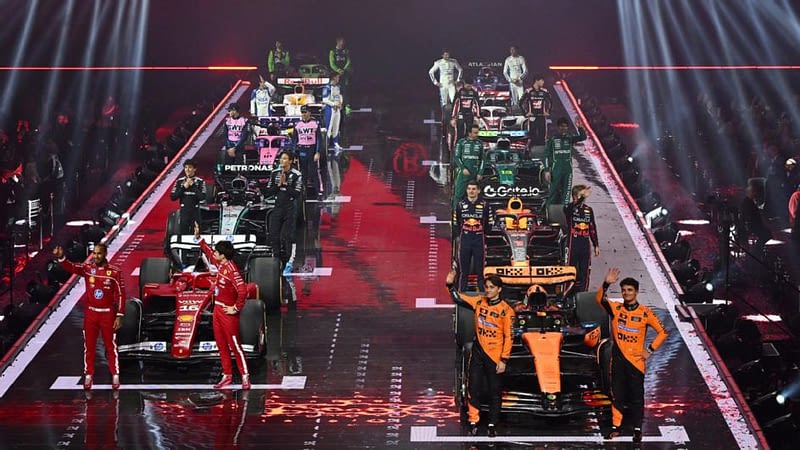Understanding the Intricacies of F1 Preseason Testing in Bahrain
Preseason testing in Formula 1 is a fascinating yet perplexing event. Fans eagerly anticipate the sight of new cars hitting the track, but without the competitive edge of a race day, the lap times recorded during these tests often hold little significance. So, what exactly do the teams aim to achieve over the three days in Bahrain, and is there anything meaningful we can extract from the timesheets by the end of the week?
Why F1 Teams Engage in Testing
Despite the meticulous engineering behind F1 cars, they essentially become 200 mph science experiments when they first take to the track for testing. Until the car leaves the garage, its performance has only been assessed in a semi-virtual realm of simulations and wind tunnel tests at the factory. Alarmingly for teams, real-world results can sometimes diverge significantly from these simulations.
During preseason testing, F1 teams embark on a rigorous process of debugging and refining to ensure their cars are as fast and reliable as possible when racing kicks off in Australia on March 16. Historically, this process spanned over 10 days or more, but in recent years, to cut costs, the number of days on track before the first race has been reduced to three.
The initial morning of testing is typically dedicated to running systems checks on the car to confirm everything is functioning correctly. Although teams have advanced test benches at their factories and likely completed a 200-kilometre shakedown before official testing, nothing compares to running the car in the intense heat of the Bahrain desert. Checks on the cooling system, hydraulic system, and electrical system are crucial to identify any reliability issues early on.
In its race specification, an F1 car is equipped with over 300 sensors generating up to 90 megabytes of data per lap. However, during testing, these numbers are even higher to gather as much real-world data as possible. Sensors on F1 cars are often too small to spot and are usually hidden under the bodywork to measure temperature, inertia, and loads. However, when it comes to understanding a car’s aerodynamics, the sensors are often impossible to miss.
Large metal fences known as rakes are attached to the cars behind sensitive airflow areas to measure air pressure and understand the flow structures around the car. These rakes consist of a series of pitot tubes that measure airspeed, and their readings are compared with the work teams conducted over the winter in the wind tunnel and via computational fluid dynamics (CFD). If the real-world data aligns with the simulations, a team is already several steps closer to unlocking the car’s true potential at the first race. If not, the team is already at a disadvantage.
Another method for understanding real-world airflow is to coat the car in “flow-vis” paint and observe how the colorful, water-based liquid spreads across the bodywork at speed. This surprisingly simple method allows engineers to determine if the aerodynamic surfaces are achieving their intended impact on the airflow.
Driver feedback is another crucial tool for understanding a new car. Steering feedback and brake feel are early boxes to tick, although it can take more than half a season before a driver is truly satisfied with the finer details. Drivers can also assist engineers in identifying where lap time is being lost by describing the car’s behavior at various stages of different corner types.
Once it’s confirmed that the car’s fundamentals are operating as they should, teams shift their focus to setup. Finding the right setup is vital to unlocking performance, and this process will occupy the majority of the three days of testing.
- Understanding how a car reacts to different ride heights, wing angles, and suspension settings helps the team build a toolbox of solutions to exploit in various situations later in the season.
- Engineers will spend significant portions of testing conducting “sweeps” through different setup combinations to determine what works and what doesn’t across different fuel loads and tire compounds.
- Acquiring as much knowledge as possible at this stage of the year can pay dividends later in the season when handling issues arise in the heat of competition.
By the final day of preseason, the goal is to have a reliable car that responds well to setup changes, along with extensive data to guide the next steps of car development back at the factory.
Deciphering Who’s Fast and Who’s Not
The lap times displayed on the timing screens rarely provide an accurate picture of the competitive order. A light fuel load and a fresh set of soft tires can make an average car appear faster than the most competitive car on high fuel and used hard tires. Consequently, the order at the end of each day can be misleading.
Tire compounds are crucial to one-lap performance in testing. Pirelli’s compounds are numbered C1, C2, C3, C4, C5, and C6, with C1 being the hardest compound and C6—a new compound for use at street races this year—being the softest. Softer rubber offers more chemical grip and performance but is less durable over several laps. The fastest times in testing are usually set on softer-compound tires, but if a car using C2s is only a tenth of a second slower than a car on C5s, it’s likely the car on the harder compound has an underlying pace advantage.
Temperatures also fluctuate throughout the day, with Bahrain offering its optimal track conditions once the sun has set and the tarmac has cooled. As a result, a time set on C5s in the heat of the midday sun is not comparable with a time set on the same compound under the floodlights late in the day.
A car’s fuel load is another major factor in performance, with as much as 10 kilograms adding roughly 0.3 seconds of lap time. Put another way, a car with a full tank at the Bahrain International Circuit can be as much as 3.5 seconds per lap slower than when it’s running with just enough fuel for a single lap.
From the outside, there’s no way of knowing how much fuel a car has on board, and teams are not obliged to disclose this information. As a result, the most impressive lap time in testing might be set by a team running with 60 kilograms of fuel in the tank, while a fundamentally slower car can appear surprisingly competitive by running with 10 kilograms on the same tires at the same time of the day.
Loading the car with fuel during testing is often referred to as “sandbagging”—F1 lingo for a team intentionally hiding its performance—but the truth is that a fuel load between 60 kilograms and 30 kilograms offers a more practical baseline for understanding car performance.
Despite the fastest times painting an unreliable picture, it’s still possible to piece together who’s quick and who’s not by delving deeper into the available data. By recognizing certain patterns in the lap times, it’s possible to gain a better understanding of what’s really happening and start making predictions about who has made the most significant performance gains over the winter.
One way to eliminate the uncertainty over fuel loads is to look for teams attempting race simulations. Most teams aim to complete one by the end of the three days to gain an understanding of how the car performs over a grand prix distance as fuel levels decrease and tire wear sets in.
To complete a race distance without returning to the garage to refuel, cars need to leave the pits at the start of the run with close to the maximum fuel load of 110 kilograms. These race simulations can be identified by spotting 57-lap stints in the timing data. Once we know cars are starting with the same fuel load to complete the same number of laps, it becomes much easier to compare performance.
It’s not an exact science because the time of day, track conditions, engine modes, and tire strategies can skew the results, but as a general rule, it is the best way to build a more accurate picture of performance by removing some of the questions over fuel load.
While some kind of order usually emerges from testing, it’s not always representative of the first race. A car that’s quick at the Bahrain International Circuit—a track that rewards good traction, braking stability, and low rear tire degradation—might not be as competitive at Melbourne’s Albert Park, which has a smoother track surface, different corner profiles, and a more unpredictable climate.
Moreover, teams will strive to develop their cars as much as possible between the first test and the first race, with upgrade packages already in the works for the opening few races. A car that starts slowly in testing might also be a few setup changes away from unlocking significantly more pace, and the key to that performance might only present itself after test data has been fully analyzed back at the factory.
Originally Written by: Laurence Edmondson





















